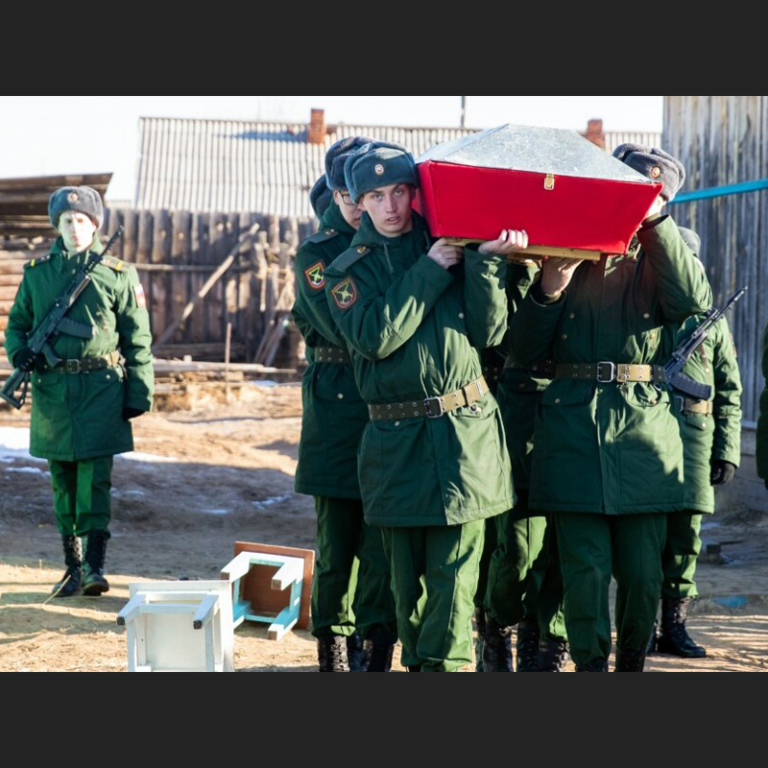
Since February 24, 2022, the “mighty Russian man” has been presented with a “glorious future” — to be sent to die on Ukrainian territory. The aggressor country, which has considerable human resources, throws them into the Russian-Ukrainian war. Statistics indicate that primarily national minorities of the Russian Federation are sent to fight for Russia. Despite this, native Russians constantly complain of Russophobia while simultaneously oppressing representatives of the national minorities that live alongside them.
!
The material contains links to Russian websites that can be viewed via VPN.Russia hardly cares about preserving the identity of the 200 ethnic groups residing in its territory. Xenophobia, racism, and the supremacy of the “mighty Russian man” over all others dominate the country. Ethnic minorities and indigenous peoples do not receive adequate funding for the development of their republics. They do not have legal rights to preserve their cultures and languages (almost 136 languages are on the verge of extinction). People are persecuted and oppressed because of their national origin.
Xenophobia
Non-acceptance by a person or community of someone else's culture, language, behaviour, etc.; at the state level — discrimination on national and cultural grounds.In addition, Russia pursues an imperial policy inherited from the USSR and its tsarist predecessors. The country gradually and systematically assimilated various peoples to exploit them for its purposes. This process is especially noticeable during a full-scale invasion when losses among the national communities of the Russian Federation are much greater than among ethnic Russians.The disdainful and self-interested attitude towards the “non-titular population” prevailed in Russia even during the time of Peter the Great. Soviet historian Vladimir Lapin wrote that its army has long been a part of the imperial integration mechanism. In the 19th century, Russian public administrator and colonel Aleksandr Rittikh emphasised that the main task of the Russian army concerning the Jewish population was to russify it through military training because only Russians are “superior people” capable of military affairs. That is, they wanted to develop the Jews into exemplary Russians. In his opinion, the next generation of Jews should eventually become excellent troops to reinforce the Russian army.
Russian governor-general Andrey Selivanov said that all ‘foreigners’ must be Russified. In some cases, this Russification was supplemented by attempts to convert the national minorities to Eastern Orthodoxy because the empire mistrusted Muslims.
Additionally, creating military units comprised of the natives of the North Caucasus was considered a demonstration of Russian superiority and subjugation of other nations.

A similar policy was implemented during the Soviet era. In 2010, Putin said that the victory in World War II took place at the expense of exclusively Russia’s human and industrial resources. However, he did not specify that out of the 27 million total losses, the loss of Russian lives amounted to approximately 5.7 million. The remaining losses were among other nations of the republic. These statistics also show that the Russian Federation has adopted the policy of its predecessor, the Soviet Union, which did not care about the fate of ethnic minorities and treated them as an expendable resource for achieving the objectives of the regime.
From the “hinterland” to a “glorious” war

During a little more than the first five months of the full-scale war, Russia lost almost 43,000 of its military personnel in Ukraine (as of 08/10/22). Another 90 thousand (as of July 1, 2022) have been wounded, and there is no way to count those who are missing.
For a whole month after the beginning of the full-scale invasion, the Russian Federation did not make any official statements about its fallen soldiers. Even after breaking the silence on military losses, their reports stopped in March at 1351 people. Later, on June 1, 2022, Andriy Kartapolov, chairman of the Russian State Duma Committee on Defence, stated that due to a change in the approach to conducting hostilities, the Russian army essentially stopped suffering from losses. Allegedly, this was the reason why the last time information about the losses was made public was in March.
The authorities of the Russian Federation, along with the propagandists, convinced everyone that ‘everything is going according to plan’ and ‘there are no losses’». However, there were significant losses for the ‘second greatest army in the world.’ Even in the sixth month of the full-scale war, the aggressor country’s government did not make official statements about its losses. However, the analysis of information from open sources, such as social networks of relatives of the deceased and mentions in regional and local media, proves that the situation is not as optimistic as it is portrayed. And even though the data is incomplete, the deaths of representatives of ethnic minorities are reported more than that of ethnic Russians.
While the government of the Russian Federation remains silent, Ukrainian investigative journalists of the “Information Resistance” discovered, by studying open Russian sources, that 5001 Russian occupiers have been officially publicly buried or recognised as killed (as of July 26, 2022). As noted by the project team, many deceased Russian soldiers have been buried secretly. There is also a practice of deleting official messages about the dead that include the date and the exact time of their funerals. A significant number of Russian soldiers remain in the “missing” category.
The five regions with the largest number of losses include the Republics of Dagestan and Buryatia, the Krasnodar Krai, Bashkortostan, and Volgograd Oblast. The statistics also show significant disparities: the number of dead soldiers from poor regions (where ethnic minorities live) is much higher than in developed ones.

For example, until the end of April, there was not a single officially registered death of a soldier from Moscow, a city with a population of at least 13 million people (according to statistics of 2022). While in Dagestan alone, where about 3 million people live, 93 deaths were recorded during the same period. In Buryatia, where almost 1 million people live, 52 deaths were recorded. Military volunteers are not being recruited in Moscow, although for the Far Eastern and Siberian Federal Districts, the government set a norm of 200 “volunteers” every week.

Concerning losses of the Orenburg Oblast confirmed in the mass media, slightly less than 40% of the dead were representatives of non-Slavic ethnic groups. Notably, at the time this material was being published, the lists of soldiers fallen in Ukraine were removed from the website.
The corresponding confirmed losses in the Astrakhan Oblast amounted to 80%, although non-ethnic Russians make up only 32% of the population here.

If you look at one of the lists of wounded Russian soldiers who were placed in a hospital in the Rostov region, you can see that half of them are the names of people belonging to ethnic groups of the republics of the North Caucasus.
Before the start of the full-scale invasion, representatives of the Russian national minorities signed contracts with the army more often than ethnic Russians. This was because they lived in depressed regions and for them, it was almost the only way to receive a decent salary. Various indicators prove that these regions are depressed areas. For example, as of 2012–2014, the Chechen Republic and the Republic of Ingushetia had the highest rate of unemployment. The situation was not much better in the Republic of Tuva, Altai Republic, and Amur Oblast. And in 2021 the most prosperous of the republics were Ingushetia (30.9% unemployment), Dagestan (15.1%), Tuva (15%), Chechnya (14.5%), North Ossetia–Alania (13.4%), Karachay-Cherkess Republic (12.3%), and Altai (12%).
Many studies demonstrate that the economy of the Russian Federation’s subjects is developing extremely unevenly: some are very rich, while others are very poor. According to 2016 data, 70% of Russians live in the three poorest regional groups of Russia, and 30% live in the three most prosperous. The level of GDP for most Russians is the same as that of the developing countries of the Third World. It turns out that the Russian Federation is only “powerful and wealthy” in propaganda TV shows.
Developing countries
Countries with low per capita income compared to developed countries such as the United States, Japan, Germany, etc.
The fact that the country’s national and ethnic minorities live in worse conditions is evidence of the state’s general policy, which does not allocate enough funds for their development. For instance, despite the fact that Russia is the world leader in gas exports, gas service to its population remains low. The average indicator in the country is 71%, but some regions do not even reach 20%. In particular, only 13.1% of Altai had gas service at the beginning of 2021.

After a few months of the war in Ukraine, the national minorities of the Russian Federation began to realise the scale of the problem, protest, and refuse to serve. For example, in mid-July, more than 500 contractors from Buryatia submitted reports of resignation from the army. Due to the sheer number of losses, few families left in the republic have not been affected by the war. Some have lost relatives, and some have lost classmates, friends, or acquaintances. The death rate has risen by 270%, and we are only talking about confirmed data on the deaths of Buryat men under 30 in Ukraine.
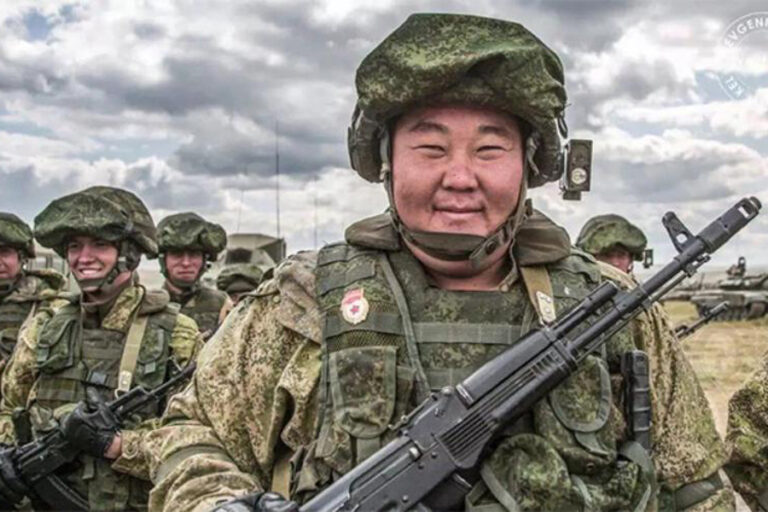
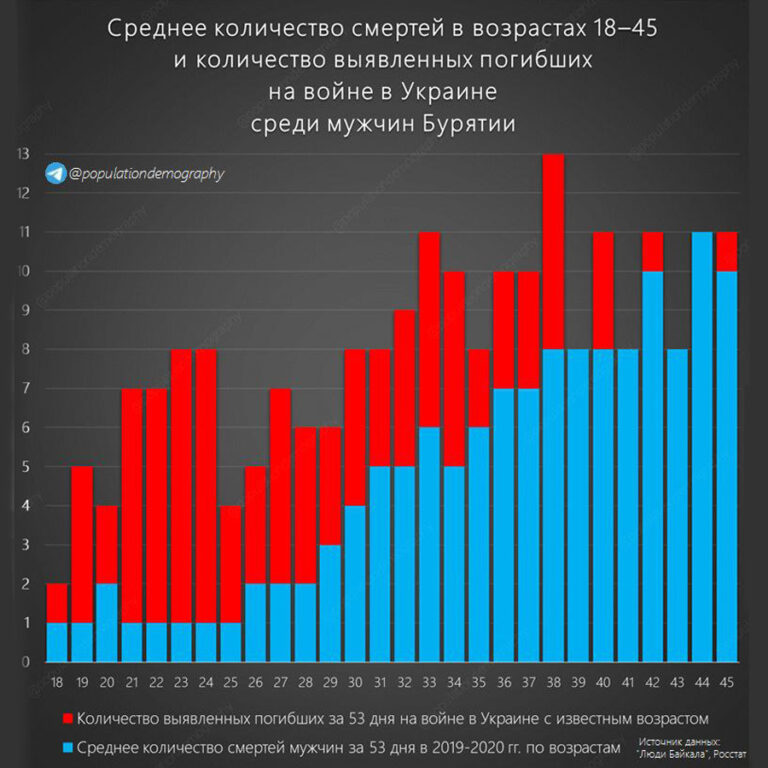
slideshow
However, Buryats conscripted into the military cannot get out of Ukraine that easily. Human rights defender from Buryatia Victoria Maladaeva said that some military turned to her because after writing reports, their phones were taken away, and they were forcibly returned to combat zones. Candidate of historical sciences Rajana Dugar-De Ponte notedthat the Russian army wanted to shift the blame for the atrocities committed in Bucha to the Buryats by circulating fake photos (not of Buryats, but Yakut soldiers, and taken in 2018).
Apart from going to war, people in Buryatia do not support the “denazification of Ukraine” narrative either. After all, the republic’s population is constantly discriminated against by ethnic Russians, who, on the other hand, supported the idea of denazifying Ukraine.

Russia, as a typical empire, unleashes long wars and is prepared to win at the cost of the lives of its colonial troops. It purposefully recruits and sends the so-called “underprivileged” population to war, turning them into cannon fodder. The vertical hierarchy of the Russian army and the correspondingly different attitude toward soldiers is also evident in its specific division into castes.

The highest caste is the chosen ones, who can even be representatives of the special services. Sometimes they do not even have military experience as, for example, employees of the Federal Security Service (FSB). Kadyrovites are the next most privileged caste. These are Chechen military personnel subordinate to the leader of the Chechen Republic, Ramzan Kadyrov, who, in turn, carries out orders from the Kremlin. These soldiers are also called “TikTok troops” because of their activity on social media. Now the Russian Federation is trying to use the reputation of the “Kadyrovites” as cruel and merciless warriors to intimidate the civilian population in Ukraine. However, Russia wants to downplay its history here. During the First Chechen war (1994–1996), in response to the brutal crimes of the Russian military, Chechens took revenge by executing Russian prisoners of war and filming it on video. These events established Chechens’ image as “militant thugs.” However, many Chechens still fight for their independence and do not support Putin’s rule. For instance, three volunteer Chechen battalions are already fighting against the Russian Federation in its full-scale war in Ukraine. Some have been operating since 2014, for example, the Sheikh Mansur Chechen Battalion.

Next in the army hierarchy are contract servicemen, and the lowest caste are those without any rights. These are conscripts from the hinterland who have just turned 18 and ordinary workers of plants, factories, and enterprises, who are taken to the army straight off the street. Often, the government gives no regard to the level of military training of such soldiers, because their main goal is to ensure a continuous rotation of people on the frontline.
This caste also includes people from the territories that Russia has invaded. In particular, this concerns the Ukrainian territories occupied since 2014. Russia is actively using military personnel from the self-proclaimed DPR and LPR in the war against Ukraine. Mobilised men are thrown into hot spots without appropriate weapons, food, or equipment. Sometimes, soldiers don’t even have time to complete training, as they quickly get injured or die. Significantly, the mobilisation in these self-proclaimed quasi-states was announced on 19 February 2022, i.e. three days before Moscow recognised their so-called independence and launched a full-scale war.
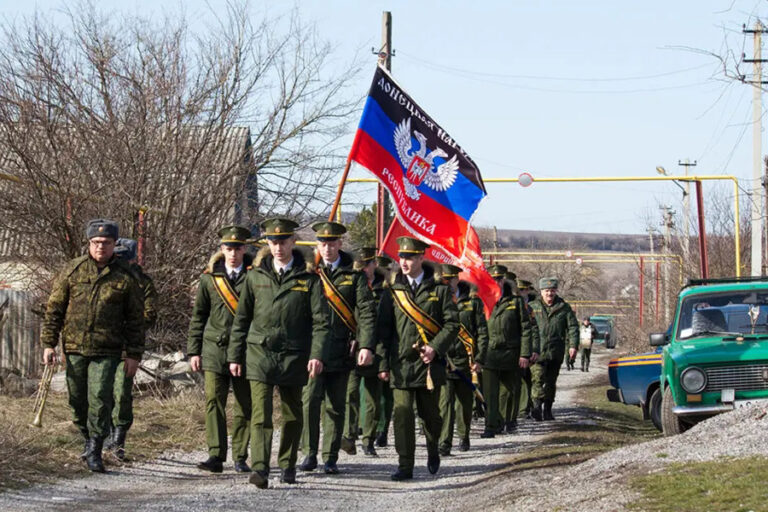
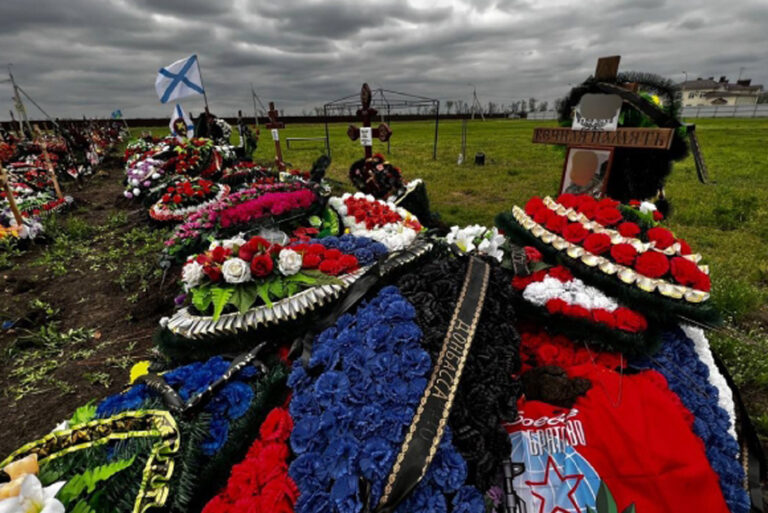
slideshow
The same story unfolds in the territories newly occupied since the full-scale invasion. Ukrainian intelligence reveals that the Russian occupiers have begun forced mobiliіation, in particular, of doctors, in the settlements of Slobozhanshchyna, Tavria, Zaporizhzhia, and Podniprovia. The invaders are trying to conduct a population census, demand that condominium managers submit lists of residents of conscription age, and also take people to the army from military checkpoints or simply from the street. If people do not consent, they are threatened with shooting. Having a passport from the Russian Federation is often considered a sufficient condition for mobilisation, which is why the occupiers are actively engaged in the forced issuance of Russian passports to the population.
Collective Russian xenophobia
The Russian Federation positions itself as a large, multicultural, and multinational country. Indeed, more than 190 nationalities live there, including various ethnic groups and indigenous peoples. The largest ethnic group is the Russians (77.7%). Next, come Tatars (3.8%), Ukrainians (1.4%), Bashkirs (1.1%), Chuvash (1%), and Chechens (1%), and the rest are other smaller ethnic groups. All non-ethnic Russians make up about 20% of the population, which is about 29 million people (for comparison, it’s two-thirds of Poland’s population).

Despite such diversity, in “glorious” Russia, ethnic minorities are despised, and their culture and identity are destroyed in every possible way. They are considered “untitled” and “inferior.” Most Russians are infected with the propaganda of the “glorious Russian man,” and it is present in almost all public messages. When talking about external Russophobia, Russians forget that they themselves despise the people of their own country, which is explicit even at the linguistic level.
Xenophobic narratives have firmly entered the everyday language of Russians. For example, in one of the Russian dictionaries, there is even such a definition: “chernozhopy (Rus. for “having a black ass” – Tr.) — a person of non-Russian nationality, a Caucasian, or a resident of Central Asia.” Also, Russian dictionaries describe the inhabitants of the Caucasus, the South Caucasus, and Central Asia with the ethnic slur of “churka”, interpreting it as “stupid, dumb person”. The derogatory word “khach” is used for Armenians and Azerbaijanis.

According to 2019 study, 1 in 2 Russians support the slogan “Russia for Russians” and feel hatred toward “foreigners.” The researchers also found that since 2017, the level of ethnophobia has increased from 54% to 71%. And 40% of the population considers it necessary to restrict the residence of Romani in Russia. Support for the limitation of other nationalities is as follows: 39% — Chinese, 32% — natives of Central Asia, 31% — natives of the Caucasus, 18% — Ukrainians, and 17% — Jews. As you can see, the Russian soul is not as friendly and welcoming as it has been singing about for years.
Ethnophobia
Prejudiced, hostile attitude towards a representative of a certain ethnic group, which has no objective grounds.Thus, on 24 October 2013, Russian politician Volodymyr Zhirynovsky, speaking on the TV channel “Russia 1”, even called for the introduction of birth limits in the North Caucasian region of Russia and emphasised the need to “restrict the territory of the Caucasus with barbed wire.”

Repeatedly, such beliefs about non-ethnic Russians have been the cause of ethnic and racial violence. Some survivors reported that they heard offenders chanting the phrase “Russia for the Russians” while they were being attacked. One of the notorious cases of violence against a person of non-Slavic appearance was the murder of a 9-year-old Tajik girl in St. Petersburg in 2004. A group of teenagers attacked her and her father. Notably, the court recognised it as hooliganism and the perpetrators did not suffer an appropriate punishment.

Hospitality and good manners are obviously not the strong suits of Russians. In 2013, radical groups organised the so-called “Russian Purge.” These were actions in various districts of St. Petersburg to stop illegal street trade allegedly being carried out by foreigners. During these “cleansings’, participants attacked migrants, overturned fruit and vegetable stalls, used offensive language, and rudely demanded that people leave Russia.
Deliberate destruction of culture and education
Many nations living in the territory of the Russian Federation lose their identity, language, and culture over time precisely because of their country’s politics. Ukrainians are one of the largest ethnic groups there, although not of their own will. For the most part, ethnic Ukrainians came to live in Russian regions because of Russia’s colonial policy.

Kuban is the region of Russia with the highest population of Ukrainians. Historically, it was inhabited by Ukrainians but belongs to present-day Russia. Ukrainians also reside in the Russian territories of the Far East and Siberia, where they were sent and deported under the brutal policies of the Soviet regime.
Currently, the country is home to one of the largest communities of the Ukrainian diaspora in the world. As of 2010, there were 2 million Ukrainians, of which almost 700,000 were fluent in Ukrainian. Despite this, there are no Ukrainian schools and no rights for Ukrainians to preserve their ethnicity in the Russian Federation.

After its occupation of Crimea, Russia gradually reduced opportunities to formally study the Crimean Tatar language on the peninsula and also ultimately terminated the study of Ukrainian. Russia made these changes despite the fact that the International Court of Justice commanded it to ensure the availability of appropriate education to national minorities. Moreover, you can even be fined for speaking Ukrainian in public in Russia. For instance, in 2022, the radio station “Echo of Moscow” was forced to pay 3,000 rubles for their program about Ukrainian culture titled “What do they have there” (on air in 2017) broadcasted in Ukrainian.

The status of book collections is also critical. For example, Moscow Library of Ukrainian Literature employees were persecuted for a long time. The institution was routinely searched, and books were seized for examinations. Interestingly, even the children’s magazine “Barvinok” was included in the list of illegal materials. In 2017, the library was closed.
The most prominent organisations of Ukrainians in Russia were also oppressed, namely the Federal National-Cultural Autonomy of Ukrainians in Russia (terminated in 2010) and the Union of Ukrainians in Russia (terminated in 2012).
There are also challenges with education in the Tatar language. There are officially 702 Tatar schools in Russia, of which 515 are separate schools, and 187 are branches. However, not a single one of them actually teaches in the Tatar language.
Schools in the Republic of Tatarstan are increasingly switching to Russian as the language of instruction, as students need it to pass exams and enter universities. The presidential decree of 2009 eliminated the possibility of taking any state exams in the local language. Textbooks translated from Russian into the ethnic language are also considered invalid there: they are registered as educational aids, so a child who received an education from them is not entitled to a certificate.
Insufficient funding of education in the republics and low birth rates are among the reasons for the low instances of teaching in the languages of national minorities. Consequently, schools are closed in villages, so children are forced to either go to study in other settlements or switch to schools where education is in Russian. The second option is often more affordable financially.
In addition, there are native Russians who live in various republics of the Russian Federation and oppose the mandatory study of the languages of national communities in schools. Therefore, they file complaints in court. such cases occurred in Tatarstan, Bashkortostan, and Komi. In 2017, at a meeting of the Council on Foreign Relations, the President of the Russian Federation commented on such precedents and stated that “forcing a person to learn a non-native language is unacceptable, and the Russian language is the state language of international communication and a natural spiritual framework that cannot be replaced by anything.” That is why, already two months after Putin’s statement, all republics have had to increase the number of lessons taught in Russian and introduce the teaching of the state languages of the republics only on a volunteer basis .
Activists in the republics have tried to oppose such laws and fight for their rights. Asa sign of protest in 2019 in Udmurtia, scientist Albert Razin set himself on fire near the building of the State Council. He demanded that the authorities pay more attention to protecting the Udmurt ethnic group and language, and repeatedly sent letters with requests to Moscow, but received only short, automated answers. For the last time in his life, he went to a solo protest with a poster saying: “And if tomorrow my language disappears, then I am ready to die today.”

The problem with culture and language in Udmurtia is indeed crucial. According to the results of all-Russian population censuses 2002 and 2010, over these eight years, the number of people who know Udmurt decreased by 30% — from 463,000 people to 324,000.
Apart from that, at the beginning of 2018, UNESCO published an updated atlas of the world’s endangered languages. As many as 136 of them were found in Russia. 20 of them are considered extinct, and another 22 are criticaly endangered. However, despite such problems, the Russian authorities are in no hurry to change anything. This demonstrates the imperial essence of the Russian Federation. It is much easier and more convenient not to allow national communities to develop independently, but to control and assimilate them completely.
Restrictions on civil rights and freedoms
The Russian Federation also discriminates against ethnic peoples in the labour market. In 2018, sociologists conducted a study and found that companies are less likely to invite representatives of ethnic groups from the south of the Russian Federation to job interviews. Groups of European origin, including Russians, were favoured.
There are restrictions on national communities concerning political engagement: Russian legislation prohibits the creation of political parties based on ethnic or religious affiliation.
Also, in 2022, the Russian Federation began to discuss cancelling local governors’ elections. Formally, the Kremlin is already the chief leader of the regions, as it is always required to approve the governor’s candidacy in the presidential administration.
The propagandist media share the xenophobic sentiments imposed by the government. Along with glorifying all things Russian in the media, their content is often biased and racist. Thus, journalists permanently associate Roma and Tajiks with drug trafficking and crime and Caucasians (especially Chechens) with terrorism.
Police officers also take part in ethnic discrimination. 2019 research shows that they are often involved in ethnic profiling and show prejudice against people of non-Slavic appearance. For example, in the Moscow subway, black people are 22 times more likely to be stopped for inspection. There have also been cases when Roma women had their hair cut while being held under arrest. The Roma perceive the forcible cutting of a woman’s hair as a shameful act comparable to rape.
Ethnic profiling
Discrimination of national communities by law enforcement agencies.The results of a 2014 study prove that some police representatives generally interpret their role as protecting Russian society from certain social groups, and not as protecting every person regardless of their ethnic, cultural or religious background.
Eraditaction of indigenous peoples
Russia is also home to small indigenous peoples of the North and the Far East. They lead a traditional lifestyle, often in a dangerous climatic environment. For example, some of them live in tundra. The temperature there can be up to -40°C in winter, and up to +10 °C in summer, but this warm period lasts only 2-2.5 months a year.
According to Norwegian researcher of indigenous peoples, Aileen A. Espiritu, the Russians have always treated non-European peoples of Russia such as the Khanty, Mansi, and Iamalo-Nenets as inferior races and exploited them for their resources. Forced tsarist colonisation of their native territories in the north of Western Siberia and the Northern Urals began as early as the 16th century.

The literacy level of these peoples is lower than that of the rest of the population of the Russian Federation. Children usually attend schools with very low instruction quality. The state does not make significant efforts to develop educational programs in these schools, so there is a problem in the regions with the teaching of the indigenous peoples’ languages. Several of them are endangered.
In 2022, at the UN Permanent Forum on Indigenous Issues, the chief elder of the Erzya people Syres Bolyaen criticised the Russian Federation’s policy towards its national republics and indigenous peoples. He stated that over the past 30 years, the Erzya people turned from a million-strong nation into a small ethnic group that is now on the verge of complete disappearance. The peoples of neighbouring regions, such as the Moksha, Udmurts, Mari, Chuvash, Bashkirs, and Tatars face the same situation.
Previously, Russian law granted indigenous peoples special rights regarding land and the preservation of their traditional way of life. However, in 2015, the government approved an articlewhich abolished these rights. This created new complications. For example, fishing is a common indigenous practice in the Pacific region of the country, but new laws require people to apply before they can fish.
The government is also trying to suppress activists who fight for the rights of indigenous peoples. For example, in the Murmansk region in 2021, Andriy Danilov, director of the Sami Heritage and Development Fund, was unjustifiably detained. Earlier, in 2018, activist Muslim Khashagulgov was killed in Ingushetia during a “special operation by law enforcement officers” or “investigative activities on the territory of a trading complex”. And in 2010, Aslan Zhukov, an activist of the Circassian youth movement, was killed in Karachay-Cherkessia. The city court of the republic acquitted the man accused of murder.

Like a typical empire, Russia builds its policy on the colonisation of other peoples and, after the conquest, tries to Russify them, discriminating in all public domains. History shows that the territories that are part of Russia are beginning to decline, and its population is being oppressed. The aggressor country is trying to inflict the same fate on all the territories it currently occupies in Ukraine. It will continue to do so with other countries until it is interfered with.

